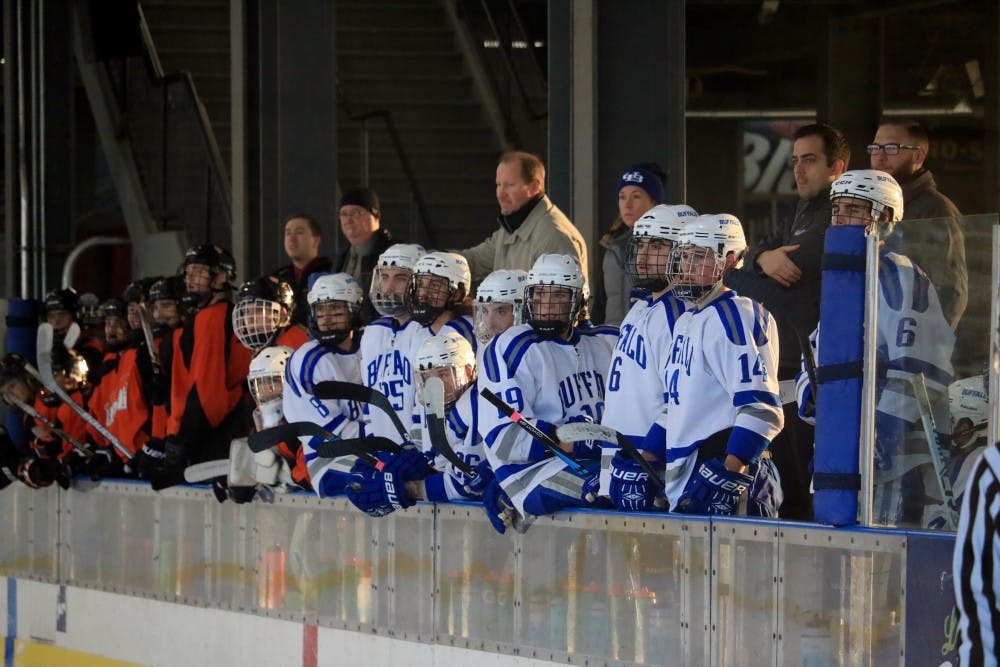UB hasn’t had a Division I hockey team since 1987, but the club hockey team is still going strong.
UB financially supports only Division I teams, but that doesn’t stop many club teams from thriving. Club athletics provides a healthy balance for student athletes who wish to continue playing the sport they love, while also having time to experience college. The club hockey program successfully creates this balance.
“I think our guys are just as committed as most other college athletes,” said head coach Jeremy Kersten. “We travel just as far as certain Division III SUNY teams like Buffalo State, Fredonia. … We’re on the ice four to five times a week, including usually two games on the weekend.”
When the team has to travel, they take turns driving their own vehicles to places like Pittsburgh and Delaware, stuffing as much equipment in cars as possible. A trip to Delaware can cost up to $80 in gas alone. Road games that start later than 9 p.m. mean the team will be driving home past midnight and arriving back in Buffalo well into the morning.
Club sports aren’t affiliated with the university budget, so practice ice is paid for and scheduled by the players and coaches. To acquire cheap and available ice time, the team schedules practice at 6 a.m. at the Northtown Center.
For just an hour of practice ice time, the team is charged $145 by Northtown Center. This rate is increased to $210 for weekend games. If the team has three 90-minute practices and two home games scheduled, they will have to dispense over $1,000 for that week. Other expenditures include equipment costs –– new hockey sticks being sold for upwards of $300 –– traveling costs and any other extracurricular events that the team holds. None of this spending is supported by the university.
“The only difference between us and the NCAA athletes is really just that we’re in the weight room less and that we don’t have the same support from the university,” Kersten said.
Players like junior center and team captain Richard Ledyard, dedicated much of their childhood to playing competitive hockey hoping to get to the NCAA level.
“I’d be traveling hours each weekend to play in tournaments,” Ledyard said. “Hockey commitment is so extreme for parents and players trying to develop at a high level and is very different compared to other sports.”
To get looks from college programs, a player needs to quit their high school team and join junior hockey programs. These junior leagues are designed to get players ages 17-21 exposure to college coaches and sign a letter of commitment.
“Lots of players on our team could have easily played Division-III hockey but decided this route instead,” Kersten said. “Some of our freshman players are as old as 21 because they were off playing junior hockey.”
Many aspiring players give up their hopes of playing in the NCAA and get burnt out having spent time and money over the years. These players make up a majority of the club hockey team.
“The idea that school comes first lines up with the club hockey mindset we have here at UB,” said junior defensemen RJ Miller. “The reason our team is so competitive is because some players had opportunities to play at divisional colleges, but came to Buffalo for their academics instead of being subject to going to school becauseof athletics.”
Other players simply cannot afford, or are unwilling, to pay to keep up with their collegiate efforts.
Division III schools cannot give out athletic scholarships, so players like Ledyard end up with the burden of paying to go to school and pressure of being on a Division I or Division III team. At UB, he can play hockey in a more comfortable environment that is a lot more affordable.
“For me it was the cost that really turned me off from playing Division III,” Ledyard said. “I’d be getting offers from schools that would make me pay a ridiculous amount of money.”
Club sports are designed exactly for players to continue playing competitive hockey, build incredible relationships, make memories and earn a college education all at the same time.
“I love being around the guys. You can really approach them like adults while teaching them,” Kersten said. “Our team goes through highs and lows together. We can bond so well because we all love hockey.”
Christopher Smith is a sports staff writer and can be reached at sports@ubspectrum.com





